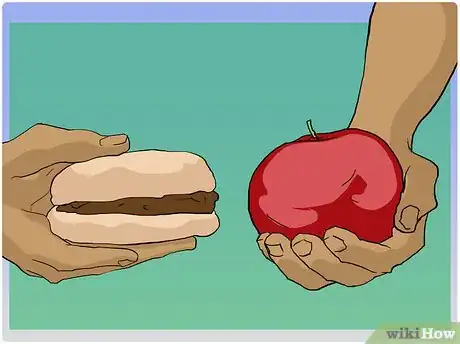wikiHow is a “wiki,” similar to Wikipedia, which means that many of our articles are co-written by multiple authors. To create this article, volunteer authors worked to edit and improve it over time.
There are 9 references cited in this article, which can be found at the bottom of the page.
This article has been viewed 60,174 times.
Learn more...
Trying to eat healthily, get enough exercise and avoid stress can be difficult at the best of times, but it's even harder when your family refuses to get healthy with you. However, with the right attitude and some determination, you can still succeed in your quest to become healthy (and maybe even convince your family to join you along the way). See Step 1 below to get started.
Steps
Focusing on You
-
1Tell your family about your decision to get healthy. Before you begin, it's important to tell your family about your plans to live a healthy lifestyle. You will need their encouragement and support, even if they are not interested in joining you on your quest to get healthy.
- If your family isn't aware of what you're trying to do, they may tempt you to eat foods that are not in your diet plan, unintentionally or otherwise. Telling them about your plan to get healthy will help them to understand when you say 'no' to unhealthy foods and hopefully make them a little more sensitive to your needs.
- Telling your family about your decision will also help you to stick to your goals, because there will be other people to hold you accountable for what you eat and what exercise you do.
- Once your family see the progress you've made — whether you intend to lose weight, increase your energy levels or get fit — they may be tempted to join you!
-
2Eat a balanced diet. Eating a balanced diet is an essential part of becoming healthy. Eating healthy food in the correct proportions can help you to lose weight, gain energy, sleep better, have clearer skin and stronger hair and nails, along with a wealth of other benefits. However, following a balanced diet when your family does not can be difficult, as it will involve preparing your own meals. Here's some info on what a balanced diet should include:[1]
- Fruits and vegetables: These foods provide the body with minerals and vitamins. It is important to eat at least five portions of vegetables and fruit per day You can do this by eating a piece of fruit with breakfast, having a green salad for lunch, eating two portions of veg with your dinner and having some fruit or veg as a snack throughout the day.
- Carbohydrates: Carbohydrates are foods that provide the body with energy. When following a healthy diet plan, it's best to eat wholemeal foods to get your daily carbohydrate intake. This includes wholemeal bread, whole-wheat pasta, and brown rice.
- Protein: Protein helps to repair worn out cells and aids in the healing process. Foods that are rich in proteins include meat, fish, eggs and beans. Stick to seafood and white meat such as chicken and turkey as much as possible when following a healthy diet, as red meat has a higher fat content.
- Healthy fats: Healthy fats are necessary for your overall health and to ensure that your metabolism is working efficiently. Good sources of healthy fats include avocados, oily fish like salmon, mackerel and trout and raw nuts and seeds like almonds, walnuts sunflower seeds and flaxseed.
Advertisement -
3Swap to healthier versions of the same foods. When your family are eating your favorite, unhealthy meals, it can be very difficult to stick to your diet plan. In this situation, it's best to substitute the food that they are eating with your own, healthier versions, as this will stop you from feeling like you're missing out.[2]
- For example, if your family are eating a pepperoni pizza from your favorite take-out, you can try making your own pizza using wholewheat flour, homemade tomato sauce and low-fat cheese, all topped with a selection of healthy veggies. In this way, you can still eat pizza with your family, but cut your calorie intake in half!
- You can also substitute your family's unhealthy desserts (like ice cream or chocolate cake) with your own healthier treats. Try having a fresh fruit salad with yogurt, eating a wholewheat muffin, or making stewed apples with brown sugar and cinnamon. You'll still get to satisfy your sweet tooth without breaking your healthy eating plan.
- Try to find foods that capture the taste and smell of tempting foods without the calories. This will make it easier to watch others eat junk foods.
-
4Control your portion sizes. If you don't want to go to the hassle of making an entirely different meal from the rest of the family, you can still eat the same foods — you just need to make an effort to control your portion sizes and make one or two healthy additions to balance out the meal.
- For example, if your family is eating spaghetti and meatballs, you can still enjoy the meal without sacrificing your diet. Just take a small portion of spaghetti (have a look at the package to see the recommended portion size), then fill the rest of your plate with steamed veggies.
- Or if you're family are eating burgers from the grill, try eating the burger without the bun (white bread is basically empty carbohydrates with no real nutritional value) and filling the rest of your plate with a healthy green salad. You still get to enjoy the taste of barbecued red meat, but it'll be guilt-free!
- Try to find out what your family is planning on eating well in advance. This gives you time to figure out what needs to be added to the dish to make the meal balanced and healthy.
-
5Drink lots of water. Drinking water is an essential part of a healthy diet — it keeps you hydrated, aids with digestion, leaves your skin looking clearer and flushes toxins from your system. It is recommended that you drink at least 8 glasses of water per day.[3]
- Sometimes we mistake thirst for hunger, so when you feel hungry try drinking a glass of water instead. Drinking a glass of water before each meal is also a good way to limit your appetite and prevent you from overeating.
- You can also increase your water intake by drinking herbal teas, so drink as many cups as you like each day. Some herbal teas have additional benefits — chamomile has calming properties, ginger aids with digestions and green tea is full of antioxidants.
-
6Exercise for half an hour per day. Exercise is an essential part of any plan to get healthy, because it helps to burn extra calories and to distribute nutrients to different parts of the body. Exercise also helps to prevent diseases such as diabetes, hypertension and obesity.
- It is important make exercise part of your plan to get healthy and stick to it. Studies show that even ten minutes of physical exercise per day can have a positive impact on the body. Exercises that can be done daily include walking to work, swimming, skipping and dancing.
- Exercise is always easier if you have someone else to do it with you. Even if your family isn't ready to change their diet, they may be willing to join you for a daily run or dance class. It doesn't have to be the whole family — if you can just get your mother, father, daughter, son, brother or sister involved, the rest of the family may follow.
- Try to find an exercise that you enjoy and do it for at least a half hour each day. Even if it's difficult at first, you'll find it becomes gradually easier as your fitness increases. Don't make the excuse that you "have no time" for exercise — everybody can find an extra 30 minutes in their day, you just need to want it enough!
-
7Avoid stress. Being healthy isn't all about eating right and getting enough exercise, it also involves taking care of your mental health by avoiding stress and making sure you get enough rest. Even if your family life tends to be a bit crazy and stressful, it's important that you set aside some "me-time" as part of your health plan.[4]
- Some things you can do to de-stress and relax include yoga, meditation, reading a book and or even taking a warm bath in the evening.
- Also make sure you are getting enough sleep — you should be aiming for 8 hours per night, 6 at the absolute minimum. Getting enough sleep ensures that the body is not overworked and that you are ready to perform well at work or school the next day.
- If issues with your family or work are bringing you down, consider seeing a counselor who can help you work through your problems and come to terms with any negative feelings you've been having. Having a healthy body is no good if you're not in a healthy state of mind.
-
8Avoid getting sick. In addition to taking care of your diet, exercise and mental health requirements, staying healthy within a big family also involves avoiding sickness when it hits your household. Luckily, there are several measures you can take to avoid catching an illness from your family members.
- Hand washing is one of the most basic things that can help you to avoid becoming sick. This includes washing hands before and after visiting the toilet, before cooking, before and after changing the baby's diaper, and after touching any dirty tools or surfaces.
- It's also important to wash and disinfect your hands after touching anything that has been touched by the family member who's sick. It's a good idea to have hand sanitizer wipes or gel easily available for these situations. In addition, any toys that sick children have been playing with should be thoroughly cleaned to avoid passing the illness onto other kids in the family.
- Don't share any dishes, cups or utensils with sick family members. The dishes should be cleaned with soap and hot water after the sick person has used them — this helps to prevent spread of germs from one person to another.
- When one spouse is sick, make an effort to to face in opposite directions while sleeping and avoid kissing one another. Bed sheets should be cleaned frequently in a hot cycle in the washing machine. These precautions will help to avoid the transmission of some common ailments like the cold and flu.
Getting the Family Involved
-
1Get the whole family involved in the cooking process. Once you've adopted your own fit and healthy lifestyle, you can start slowly convincing your family to join you. One great way to do this is to get the whole family involved in the cooking process.
- Get kids to help you with baking by doing simple tasks such as sifting the flour during home baking, or beating the eggs for a healthy omelette.
- Ask family members what their specific likes and likes and dislikes are — if Dad doesn't like onions, maybe you could leave them out of the next salad you make.
- Host a family pizza night — everyone can roll out their own wholewheat pizza dough and load it with their favorite healthy toppings. This is also a fun way for the family to spend time together.
-
2Present healthy foods in an attractive way. When healthy food looks good, it makes it a lot more tempting to eat, so try to jazz up your healthy dishes by adding colorful fresh ingredients and interesting textures.
- If you're trying to get kids to eat fruit, a colorful fruit salad will look a lot more appealing than a few brown pieces of apple. Mixing in some fresh fruit juice or yogurt will also add flavor to the dish and make it more interesting.
- If you're trying to convince adult members of the family to eat salad, you may not have much luck with a boring combination of lettuce, tomato and cucumber (although these make a good base). Try adding things like strawberries or olives for color, nuts and seeds for texture and eggs and avocados for flavor. A tasty dressing made from olive oil, balsamic vinegar and crushed garlic can also help to make a salad more attractive to picky eaters.
-
3Hide healthy foods in tasty dishes. Another, sneakier way of introducing your family to healthy eating is to hide healthy foods in tasty dishes. In this way, your family can enjoy their mealtimes, but still benefit from the vitamins and nutrients that healthy food provides.
- On it's own, spinach isn't a very attractive ingredient, but if you try hiding it inside puff pastry with some garlic and low-fat cheese, your family will soon be fighting over it! You could also try introducing items like lettuce, carrots and bean sprouts inside homemade spring rolls — be adventurous!
- Making vegetable soups is another great way to get your family eating more healthily without compromising on taste. Ingredients like carrots, zucchini, broccoli, cauliflower, sweet potato and squash all work fantastically well when blended into a soup, and once you jazz them up with things like fresh herbs, a drop of cream or a splash of soy sauce, your family will forget about wanting processed foods.
-
4Use herbs and spices to make bland dishes more interesting. Herbs and spices are a Godsend for any cook who is trying to make mealtimes more interesting for picky eaters. By taking advantage of herbs and spices, you can recreate the processed flavors that your family love in a much healthier, more natural way.
- Popular spices include cumin, turmeric, cinnamon and nutmeg, while common herbs include parsley, thyme, rosemary, basil and mint. Experiment with adding different combinations of herbs and spices to meat and vegetable dishes and you'll open up a whole new world of flavor.
- You can also play around with other flavor enhancers, such as soy sauce, fish sauce, garlic and ginger, flavored salts, vegetable, beef, chicken and fish stocks, and the zest of citrus fruits.
-
5Switch to healthier cooking methods. Healthy eating isn't just about what you eat, it's also about how you cook it. So even if you're having a tough time converting your family to salad, you can easily convince them to make a couple of healthy changes to the way they prepare their food.[5]
- Instead of frying meats or boiling vegetables, switch to grilling, steaming or baking in the oven. These methods are much healthier as they don't require much fat for cooking (like frying) and don't boil away nutrients (like boiling). With a little seasoning, the food will taste just as good, but the number of calories it contains will decrease, while the nutritional value will increase.
- Switch to using healthier, unsaturated fats when cooking, such as olive oil, coconut oil and clarified butter and stay away from unhealthy vegetable and seed oils, such as corn oil, canola oil, grapeseed oil and sunflower oil. Always cook with real butter instead of margarine or lard. This simple switch can have a significant impact on your family's overall health.
-
6Introduce more variety to your meals. Variety is the spice of life, as they say, so avoid preparing the same kinds of healthy meals night after night, or your family will soon get bored and slip back into their old ways.
- For example, you could try having an Indian themed vegetable curry with brown rice one night, a chicken and vegetable Chinese stir fry another, steak and green salad the next night and grilled salmon with asparagus and sweet potato fries the next. Just because you're eating healthy doesn't mean mealtimes have to be boring!
- Also try to take turns with the cooking — another family member might come up with a fantastically delicious idea for a healthy meal, which you would never have thought of. Involving other family members in the cooking process might also help to get them more motivated about eating healthy.
-
7Eat dinner together as a family. Sitting everybody down at the table and having dinner as a family will help to reinforce the idea that you are all getting healthy together. It will also help to make your mealtimes more enjoyable, as you can talk to one another about your day and just enjoy one another's company.
- No matter how busy each of you are, it's important that you make time for one another. Eating together will also help you to stay on track with your healthy eating plan, as it's much more tempting to order take-out when you're dining alone.
- Make sure everyone in the family has their own dinnertime duty, so the work isn't left to one person. Someone can be responsible for cooking, someone else can set and clear the table, while someone else is in charge of the washing up. You can rotate these duties on a nightly or weekly basis, if you like.
-
8Organize fun physical activities for the entire family. Once you've got the healthy eating down, it's time to rope your family into doing some exercise. If you have young kids in the family they shouldn't be too difficult to convince, but older kids and busy parents might be a little more of a challenge!
- Think about organizing a family day trip at the weekend, where you all go hiking or swimming or even for a long walk through the woods. Pack a healthy picnic and take this as an opportunity to spend some quality time together.
- If you have a garden or backyard, make an effort to get outside more throughout the week. Start a soccer tournament with your kids, shoot some hoops with your sister, or do some gardening with your mother. Any kind of physical activity is good!
Community Q&A
-
QuestionHow do I be healthy and not lose weight?
 Community AnswerEat healthy foods, like plenty of fruits and vegetables, carbs, and lean meats. Exercise 3-5 times per week. Do weight training exercises to build muscle. Try to avoid sugar and processed foods. If you're unsure about what you should be eating, google "Choose My Plate" to learn more, or talk to your doctor.
Community AnswerEat healthy foods, like plenty of fruits and vegetables, carbs, and lean meats. Exercise 3-5 times per week. Do weight training exercises to build muscle. Try to avoid sugar and processed foods. If you're unsure about what you should be eating, google "Choose My Plate" to learn more, or talk to your doctor.
References
- ↑ https://www.hsph.harvard.edu/nutritionsource/healthy-eating-plate/
- ↑ https://www.nhs.uk/live-well/eat-well/healthy-food-swaps/
- ↑ https://www.hsph.harvard.edu/news/hsph-in-the-news/the-importance-of-hydration/
- ↑ https://www.apa.org/news/press/releases/stress/2013/eating
- ↑ https://www.eatforhealth.gov.au/eating-well/tips-eating-well/low-fat-cooking-techniques
- http://kidshealth.org/parent/nutrition_center/healthy_eating/toddler_meals.html
- http://newsinhealth.nih.gov/issue/feb2013/feature1
- Andrew, C. C., & Smith, C. (2013). Food isn't what it used to be: A biblical approach to health. Bloomington, IN: West Bow.
- Chauncey, K. B. (2004). Low-carb dieting for dummies. Hoboken, NJ: Wiley Pub.











































































Medical Disclaimer
The content of this article is not intended to be a substitute for professional medical advice, examination, diagnosis, or treatment. You should always contact your doctor or other qualified healthcare professional before starting, changing, or stopping any kind of health treatment.
Read More...